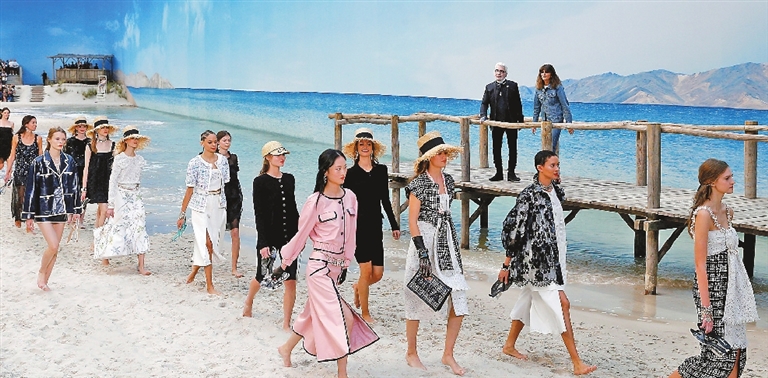
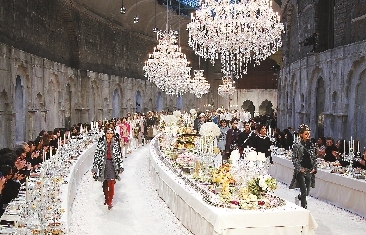

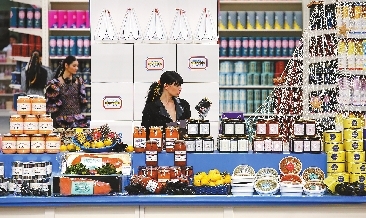
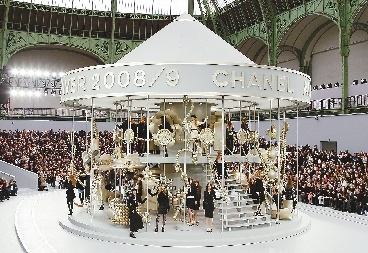
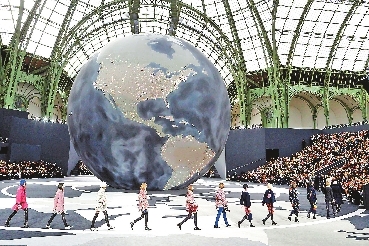
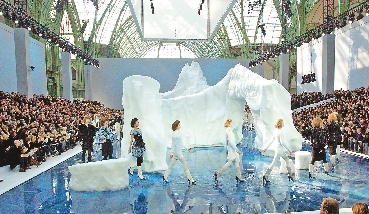

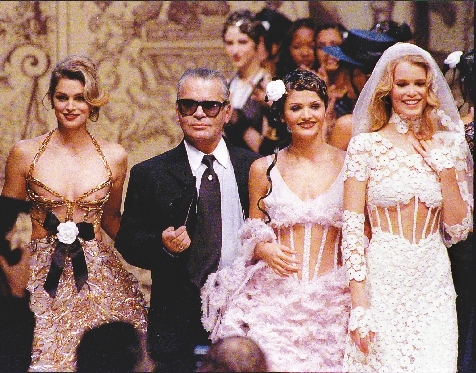
KARL LAGERFELD, who died at 85 in Paris, was one of the most prolific and widely popular designers of the 20th and 21st centuries. Lagerfeld was creative director of Chanel, the French house founded by Gabrielle Chanel, for an era-defining, age-defying 36 years. Upon assuming the reins in 1983, Lagerfeld swiftly revived Chanel, reinterpreting the house founder’s iconic tweed skirtsuits, little black dresses, and quilted handbags. He did it via the lens of hip-hop one season and California surfer chicks the next — he was a pop culture savant — without ever forgetting what the revolutionary Coco stood for: independence, freedom, and modernity. In more recent years, as the company’s fortunes grew and grew, Lagerfeld became known for the lavish Grand Palais sets he conceived for the six Chanel collections he designed a year. There was a rocket ship, a reproduction of the Eiffel Tower, and a supermarche stocked strictly with Chanel-brand products. Florence Welch sang on the half-shell at the Spring 2012 show. Most memorable of all was the improbable giant iceberg from Scandinavia that Chanel shipped across the continent for the Fall 2010 show. Lagerfeld also pioneered the concept of the traveling pre-season show. The Karl caravan has landed variously in Versailles; West Lothian, Scotland; Dallas; Seoul; and, spectacularly, Havana, Cuba. “What I love best in life is new starts,” Lagerfeld once said. In addition to his duties for Chanel, Lagerfeld was the creative director of fur and ready-to-wear at Fendi, a position he assumed in 1965. In an era of designer musical chairs, when creative directors are given three years — or even less — to make a brand work, Lagerfeld was the eminence grise that broke the rule. The multitasking designer also designed collections under his own name, but despite his international fame, neither his eponymous collections or the ones he did for Fendi achieved the status of his work for Chanel. Lagerfeld was the worthiest of successors. The public’s fascination with him rivals its interest in Chanel herself, who was the subject of numerous biographies, plays, and films both recent and vintage. There is no musical about Lagerfeld’s life yet, but don’t count him out. He cut an indelible figure with his omnipresent sunglasses, black leather gloves, Chrome Hearts rings, and powdered white ponytail. In the early 2000s, he shed nearly 100 pounds in order to wear the narrow-cut suits designed by Hedi Slimane for Dior Homme, and wrote a book about the process with his doctor called “The Karl Lagerfeld Diet.” More recent testaments to his notoriety include the public’s fascination with his Birman cat, Choupette, who is also the subject of a book and the popular “Where’s Waldo?” parody “Where’s Karl?” In the second season of “A Series of Unfortunate Events,” which aired in early 2018, the actor Neil Patrick Harris’ character, Count Olaf, donned a very Lagerfeldian disguise — high-collared shirt, strictly tailored jacket, ponytail wig — and went by the name of Gunther. “Fashion without wit is disastrous,” Lagerfeld once said, and he was rarely, if ever, without a quippy soundbite. But even as the shows became spectacles, the Chanel signature tweed suit was the canvas Lagerfeld returned to and reinterpreted again and again. The marvel of his many scores of collections is that although the silhouette changed dramatically, often from one season to the next, they all looked recognizably, archetypally Chanel. Longevity is Lagerfeld’s greatest achievement, but his career has been marked by countless smaller ones. At Chloe he defined the easeful look and feel of ready-to-wear, which was then a nascent category. In the 1990s, he began developing a second career as a commercial photographer, which enabled him to shoot his own advertising campaigns and portfolios for various international magazines. The one constant in his life was drawing; he was fashion’s most prolific and gifted sketcher. His drawings have fetched thousands of dollars at auction over the years. Lagerfeld’s ceaseless pursuit of the new at work — with six collections a year at Chanel — was reflected in his homes. Museum-worthy collections of Louis XV, Art Deco, and Memphis have been amassed and summarily sold off. Before the advent of the iPhone, he was famous for owning 300 iPods, each one programmed with different music. The only collection he never de-acquisitioned was his “zillions” of books. His home in Biarritz was said to hold “three miles” of them. So passionate a bibliophile was Lagerfeld that in 1999 he opened a small bookshop in Paris’ seventh district, 7L, and the following year launched an imprint with the German publisher Steidl.(SD-Agencies) | 
